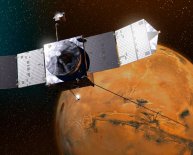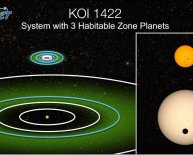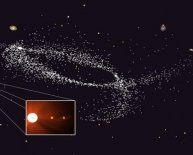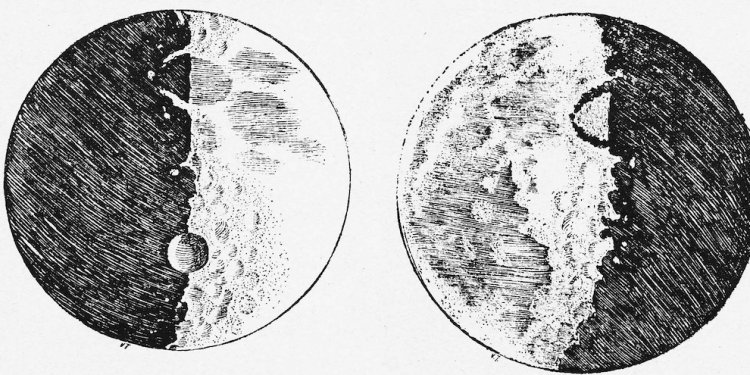
Greek astronomers
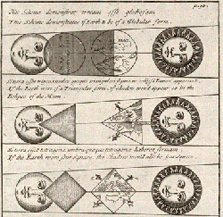 As the stars move across the sky each night people of the world have looked up and wondered about their place in the universe. Throughout history civilizations have developed unique systems for ordering and understanding the heavens. Babylonian and Egyptian astronomers developed systems that became the basis for Greek astronomy, while societies in the Americas, China and India developed their own.
As the stars move across the sky each night people of the world have looked up and wondered about their place in the universe. Throughout history civilizations have developed unique systems for ordering and understanding the heavens. Babylonian and Egyptian astronomers developed systems that became the basis for Greek astronomy, while societies in the Americas, China and India developed their own.
Ancient Greek astronomers' work is richly documented in the collections of the Library of Congress largely because of the way their tradition of inquiry continued the work of Islamic astronomers and into early modern European astronomy. This section offers a tour of some of the astronomical ideas and models from ancient Greece as illustrated in items from the Library of Congress collections.
The Sphere of the World
By the 5th century B.C., it was widely accepted that the Earth is a sphere. This is a critical point, as there is a widespread misconception that ancient peoples thought the Earth was flat. This was simply not the case.
In the 5th century B.C., Empedocles and Anaxagoras offered arguments for the spherical nature of the Earth. During a lunar eclipse, when the Earth is between the sun and the moon, they identified the shadow of the Earth on the moon. As the shadow moves across the moon it is clearly round. This would suggest that the Earth is a sphere.
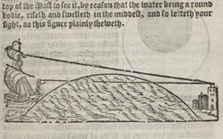 Experiencing the Sphere of the Earth
Experiencing the Sphere of the Earth
Given that opportunities for observations of a lunar eclipse do not come along that often, there was also evidence of the roundness of the earth in the experiences of sailors.
When a ship appears on the horizon it's the top of the ship that is visible first. A wide range of astronomy texts over time use this as a way to illustrate the roundness of the Earth. As the image suggests this is exactly what one would expect on a spherical Earth. If the Earth were flat, it would be expected that you would be able to see the entire ship as soon as it became visible.
Measuring the Size of the Earth
Lunar eclipses also allowed for another key understanding about our home here on Earth. In 3rd Century B.C., Aristarchus of Samos reasoned he could figure out the size of the Earth based on information available during a lunar eclipse. The diagram at the right illustrates a translation of his work. The large circle is the sun, the medium circle is the Earth and the smallest circle is the moon. When the Earth is in-between the sun and the moon it causes a lunar eclipse and measuring the size of the Earth's shadow on the moon provided part of the information he needed to calculate its size.
Eratosthenes estimated Earth's circumference around 240 B.C. He used a different approach, measuring the shadows cast in Alexandria and Syene to calculate their angle relative to the Sun. There is some dispute on the accuracy of his calculations as we don't know exactly how long the units of measure were. The measurement however was relatively close to the actual size of the Earth. The Greeks were applying mathematics to theorize about the nature of their world.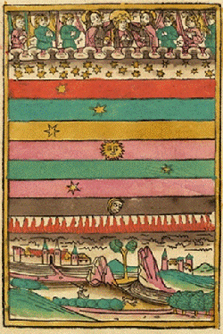 They held a range of beliefs about nature and the world but they were, in many cases, working to ground those beliefs in an empirical exploration of what they could reason from evidence.
They held a range of beliefs about nature and the world but they were, in many cases, working to ground those beliefs in an empirical exploration of what they could reason from evidence.
Aristotle's Elements and Cosmology
In the tradition of Plato and Empedocles before him, Aristotle argued that there were four fundamental elements, fire, air, water and earth. It is difficult for us to fully understand what this meant as today we think about matter in very different terms. In Aristotle's system there was no such thing as void space. All space was filled with some combination of these elements.
Aristotle asserted that you could further reduce these elements into two pairs of qualities, hot and cold and wet and dry. The combination of each of these qualities resulted in the elements. These qualities can be replaced by their opposites, which in this system become how change happens on Earth. For example, when heated, water seemingly turns steam which looks like air.
The Elements in Aristotle's Cosmic Model
In Aristotle's Cosmology, each of these four elements (earth, water, fire and air) had a weight. Earth was the heaviest, water less so, and air and fire the lightest. According to Aristotle the lighter substances moved away from the center of the universe and the heaver elements settled into the center. While these elements attempted to sort themselves out, to achieve this order, most of experience involved mixed entities.
While we have seen earth, fire, air and water, everything else in the world in this system was understood as a mixture of these elements. In this perspective, transition and change in our world resulted from the mixing of the elements. For Aristotle the terrestrial is a place of birth and death, based in these elements. The heavens are a separate realm governed by their own rules.
india map with beside countries india versus england india like bts india and pakistan india between china border india next top model 2021 india behind afghan war india by language india covid deaths india life expectancy india world cup miss india till now india at olympics india batson india ka map india to usa flights india to canada travel buy ps5 india india before mughals amazon india buy india as an emerging market india of india crossword clue india t20 world cup india official language india first life insurance india into usd india outside world cup india pro game india lil durk india via dubai india bazaar india till date vaccination indian visa application india on map india england test series india score india behind new zealand withdrawal india pro kabaddi league india and covid invesco india contra fund india without visa countries india up covid india kitchen tustin india travel restrictions india during the cold war india zip code list india out of tournament india standard time india to usa flights air india thru check in india during ww2 india next top model 2021 india of r&b crossword clue india before british india covid cases india before durk india bistro india under reported covid deaths india india first prime minister india vs nz india outside india hut india flag invesco india contra fund login india after gandhi audiobook latest news india except corona india versus england live india behind new zealand india kitchen watertown india and lil durk india over rate does pakistan border india india yuridia tour 2021 india under 18 population india bazaar near me india post india behind lahore attack india yaffe east of india beside you india before durk india coronavirus india uk india visa from usa india about cryptocurrency india ka india to us india through the eyes of a foreigner india grill india up map district india to us india pro league india since independence in hindi indian food near me india mart india over afghanistan india unemployment rate india quad india inside bangladesh india olympics 2021 midasbuy india how many hours are india in front of the uk india through my eyes india population 2021 india date and time india gdp india versus england live india news today india through a traveller's eye summary india in olympics india facts
